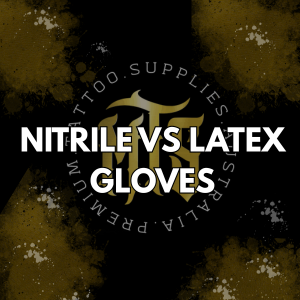🧤 Nitrile vs Latex Gloves for Tattooing: Pros, Cons & What Artists Need to Know
When it comes to tattooing, gloves are not just PPE—they're part of your setup. The right glove affects your comfort, performance, and client safety. The debate between nitrile and latex gloves continues, so let’s break down the pros and cons of each to help you choose what’s best for your tattooing needs.
🛡️ Safety First: Protection & Allergies
Nitrile Gloves
-
✅ Hypoallergenic: Latex-free and ideal for artists or clients with sensitivities.
-
✅ Chemical resistant: Offers stronger protection against inks, cleaners, and solvents.
-
❌ Slightly less tactile sensitivity (though high-quality nitrile has closed this gap).
Latex Gloves
-
✅ High flexibility: Excellent for fine motor skills and delicate shading work.
-
❌ Allergy risk: Latex can cause irritation or allergic reactions in artists or clients—an increasing concern in the industry.
-
❌ Breaks down faster with exposure to certain chemicals over time.
Verdict: Nitrile wins for safety. As tattooing involves close skin contact and chemical exposure, the lower allergy risk gives nitrile a clear edge.
🤲 Comfort & Fit
Nitrile Gloves
-
✅ Durable fit: Newer nitrile gloves (like our MTS Black Series) offer a snug, secure fit with stretch.
-
✅ Minimal sweat build-up: Many come with textured inner coatings or powder-free finishes.
-
❌ Stiffer in cheaper brands: Low-grade nitrile can feel stiff or too thick for detail work.
Latex Gloves
-
✅ Ultimate comfort: Molds to the hand like a second skin, giving a natural feel.
-
✅ Excellent stretch: Easily adapts to hand movements without resistance.
-
❌ Sweat and stickiness: Latex tends to get sticky during long sessions.
Verdict: Latex slightly edges out nitrile in comfort, but high-quality nitrile gloves come very close while offering added benefits.
⏳ Durability & Performance Over Time
Nitrile Gloves
-
✅ Tear and puncture-resistant: Handles long tattoo sessions without thinning out or tearing.
-
✅ Long shelf life: Nitrile doesn’t degrade as quickly when stored.
-
✅ Resistant to ink, oils, and cleaning products: Maintains integrity in harsh conditions.
Latex Gloves
-
❌ Degrades faster: Breaks down with repeated exposure to tattoo ink, soap, and disinfectants.
-
❌ Prone to tearing under stress: Particularly during stretch-heavy movements.
Verdict: Nitrile wins in durability. If you’re doing large-scale work or full-day bookings, nitrile is a safer bet.
🎯 Final Thoughts: Which Glove Is Right for You?
|
Feature
|
Nitrile Gloves
|
Latex Gloves
|
|---|---|---|
|
Allergy Friendly
|
✅ Yes
|
❌ No (can cause reactions)
|
|
Comfort
|
👍 Very good
|
✅ Excellent
|
|
Durability
|
✅ High
|
❌ Moderate
|
|
Chemical Resistance
|
✅ Excellent
|
❌ Low
|
|
Grip & Dexterity
|
👍 Good (high-end only)
|
✅ Excellent
|
✅ Our Recommendation
For most professional tattooists, nitrile gloves strike the best balance of safety, comfort, and longevity—especially when working with inks, solvents, and long sessions. However, some artists still prefer latex for intricate line work due to the slightly more natural feel - just ensure no client has an allergy.
At Melbourne Tattoo Supplies, we stock both premium nitrile and latex gloves to suit every artist’s preference.
Have questions about what glove is best for your workflow? Contact our team or drop by the store - we’ve got you (and your hands) covered.

